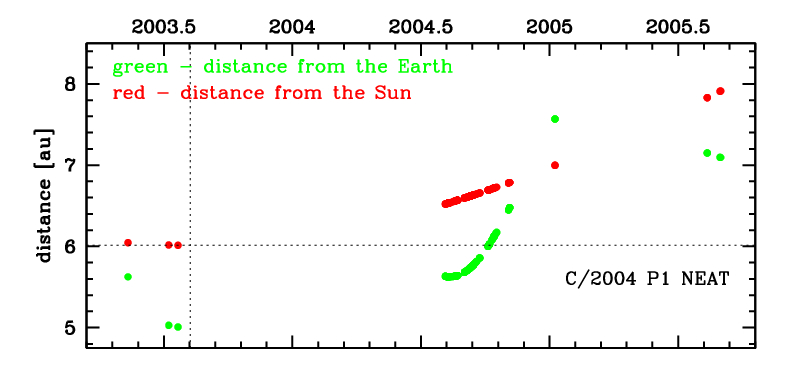C/2004 P1 NEAT
more info
C/2004 P1 was discovered on 5 August 2004 by the LINEAR as a faint diffuse comet. In the following days, its cometary apperance was confirmed [IAUC 8383, 2004 August 8]. Later, three pre-discovery detections by AMOS were found (11 May 2003, and 8, 21 July 2003). At the moment of discovery, it was one year after its perihelion passage (see figure).
This comet made its closest approach to the Earth on 20 July 2003 (5.233 au), 19 days before perihelion.
Solution given here is based on data spanning over 2.3 yr in a range of heliocentric distances: 6.05 au – 6.014 au (perihelion) – 7.91 au.
This Oort spike comet suffers small planetary perturbations during its passage through the planetary system that lead to escape of the comet from the solar system on hiperbolic orbit (see future barycentric orbit).
See also Królikowska 2014 and Królikowska and Dybczyński 2017.
This comet made its closest approach to the Earth on 20 July 2003 (5.233 au), 19 days before perihelion.
Solution given here is based on data spanning over 2.3 yr in a range of heliocentric distances: 6.05 au – 6.014 au (perihelion) – 7.91 au.
This Oort spike comet suffers small planetary perturbations during its passage through the planetary system that lead to escape of the comet from the solar system on hiperbolic orbit (see future barycentric orbit).
See also Królikowska 2014 and Królikowska and Dybczyński 2017.
| solution description | ||
|---|---|---|
| number of observations | 151 | |
| data interval | 2003 05 11 – 2005 08 30 | |
| data type | significantly more measurements after perihelion (POST+) | |
| data arc selection | entire data set (STD) | |
| range of heliocentric distances | 6.05 au – 6.01 au (perihelion) – 7.91 au | |
| detectability of NG effects in the comet's motion | NG effects not determinable | |
| type of model of motion | GR - gravitational orbit | |
| data weighting | YES | |
| number of residuals | 298 | |
| RMS [arcseconds] | 0.63 | |
| orbit quality class | 1a | |
| orbital elements (heliocentric ecliptic J2000) | ||
|---|---|---|
| Epoch | 2003 07 20 | |
| perihelion date | 2003 08 08.92381300 | ± 0.00633200 |
| perihelion distance [au] | 6.01409659 | ± 0.00003034 |
| eccentricity | 0.99873180 | ± 0.00001857 |
| argument of perihelion [°] | 16.596434 | ± 0.000685 |
| ascending node [°] | 284.193932 | ± 0.000238 |
| inclination [°] | 28.823571 | ± 0.000094 |
| reciprocal semi-major axis [10-6 au-1] | 210.87 | ± 3.09 |
